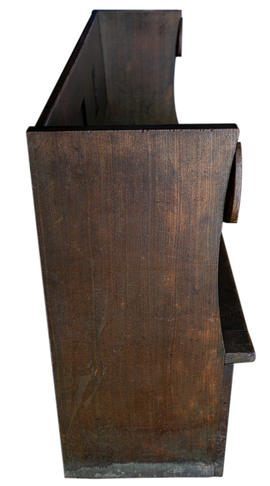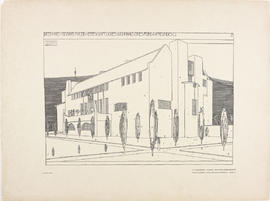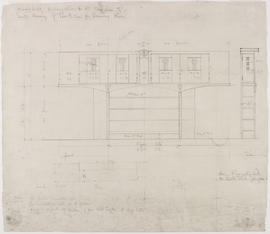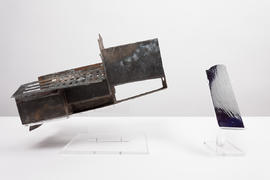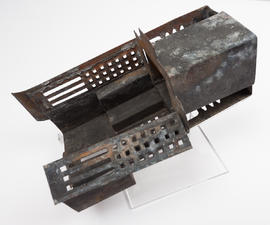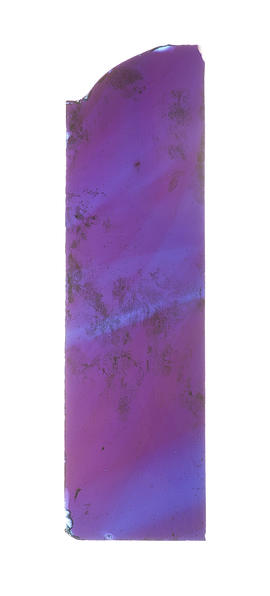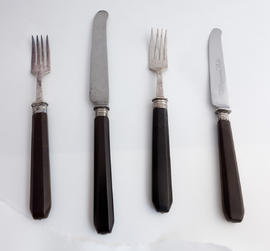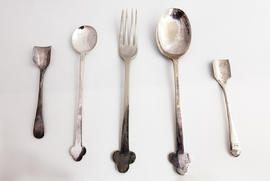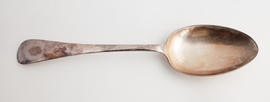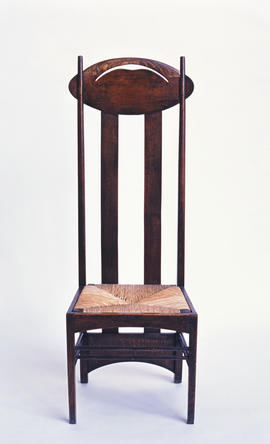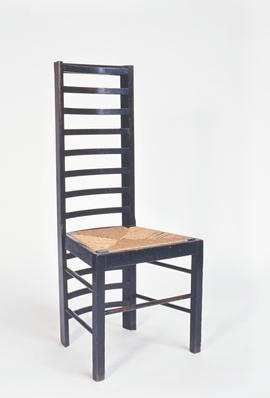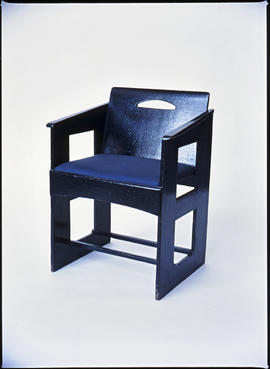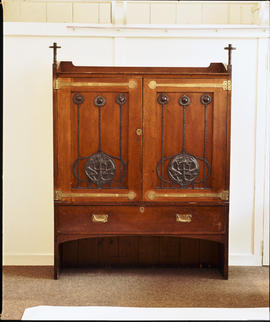Showing 135 results
Archival descriptionPlate 1 Ground & First Floor Plans from Portfolio of Prints
- MC/G/23A
- Item
- 1901
An Art-Lover's house competition. Portfolio published 1902. In 1901 the Zeitschrift fur Innen-Dekoration of Darmstadt organised an international competition for the design of an Art Lover's House. The 1st prize was shared among 16 entrants, Baillie Scott recieved 2nd prize and 3rd prizes were also awarded. Mackintosh's entry was disqualified as his interior drawings were not finished in time for the competition deadline, but when they arrived he was awarded a special purchase prize of 600 marks by the publishers. The original drawings cannot now be traced, but in 1902 Alexander Koch published them as a portfolio in 'Meister Der Innenkunst' with an introduction by Herman Muthesius. A portfolio was presented by Mackintosh to the GSA and a 2nd set of prints, framed, is in the GSA collection.The central feature of the house is the large hall - two storeys high - communicating directly with the dining room, reception and music room, which can be adapted to provide a stage. On the South side a terrace room runs outside the reception and music room. On the North side are the entrance, the hall and dining room, which are separated by a moveable partition. On the upper floor, the principal bedroom suite is partitioned off in the South-East corner; numerous guest rooms are provided and a playroom is in the attic above the childrens' bedrooms. The kitchen and servants' rooms are in the basement.
Mackintosh, Charles Rennie
Plate 2 East & West Elevations from Portfolio of Prints
- MC/G/24A
- Item
- 1901
An Art-Lover's house competition. Portfolio published 1902. In 1901 the Zeitschrift fur Innen-Dekoration of Darmstadt organised an international competition for the design of an Art Lover's House. The 1st prize was shared among 16 entrants, Baillie Scott recieved 2nd prize and 3rd prizes were also awarded. Mackintosh's entry was disqualified as his interior drawings were not finished in time for the competition deadline, but when they arrived he was awarded a special purchase prize of 600 marks by the publishers. The original drawings cannot now be traced, but in 1902 Alexander Koch published them as a portfolio in 'Meister Der Innenkunst' with an introduction by Herman Muthesius. A portfolio was presented by Mackintosh to the GSA and a 2nd set of prints, framed, is in the GSA collection. Muthesius in his introduction to the 'Meister der Innen Kunst' portfolio, stresses the impact and novelty of Mackintosh's design. 'The exterior architecture of the building... exhibits an absolutely original character, unlike anything else known... The mass of the building consists of a large plain black, without any breaking up of the walls, the effect being sought for in unbroken uniform surfaces... the windows have the appearance of accidental openings deeply recessed in the walls... Ornament, save in two or three places, is conspicuously absent, all allurements being sternly repressed in order that the desired effect of plainness reticence and therewithal of mystery and height, might be revealed as strongly as possible.
Mackintosh, Charles Rennie
Plate 5 View from South-East from Portfolio of Prints
- MC/G/27A
- Item
- 1901
An Art-Lover's house competition. Portfolio published 1902. In 1901 the Zeitschrift fur Innen-Dekoration of Darmstadt organised an international competition for the design of an Art Lover's House. The 1st prize was shared among 16 entrants, Baillie Scott recieved 2nd prize and 3rd prizes were also awarded. Mackintosh's entry was disqualified as his interior drawings were not finished in time for the competition deadline, but when they arrived he was awarded a special purchase prize of 600 marks by the publishers. The original drawings cannot now be traced, but in 1902 Alexander Koch published them as a portfolio in 'Meister Der Innenkunst' with an introduction by Herman Muthesius. A portfolio was presented by Mackintosh to the GSA and a 2nd set of prints, framed, is in the GSA collection.Muthesius in his introduction to the 'Meister der Innen Kunst' portfolio, stresses the impact and novelty of Mackintosh's design. 'The exterior architecture of the building... exhibits an absolutely original character, unlike anything else known... The mass of the building consists of a large plain black, without any breaking up of the walls, the effect being sought for in unbroken uniform surfaces... the windows have the appearance of accidental openings deeply recessed in the walls... Ornament, save in two or three places, is conspicuously absent, all allurements being sternly repressed in order that the desired effect of plainness reticence and therewithal of mystery and height, might be revealed as strongly as possible.
Mackintosh, Charles Rennie
Plate 12 The Hall from Portfolio of Prints
- MC/G/34A
- Item
- 1901
An Art-Lover's house competition. Portfolio published 1902. In 1901 the Zeitschrift fur Innen-Dekoration of Darmstadt organised an international competition for the design of an Art Lover's House. The 1st prize was shared among 16 entrants, Baillie Scott recieved 2nd prize and 3rd prizes were also awarded. Mackintosh's entry was disqualified as his interior drawings were not finished in time for the competition deadline, but when they arrived he was awarded a special purchase prize of 600 marks by the publishers. The original drawings cannot now be traced, but in 1902 Alexander Koch published them as a portfolio in 'Meister Der Innenkunst' with an introduction by Herman Muthesius. A portfolio was presented by Mackintosh to the GSA and a 2nd set of prints, framed, is in the GSA collection.This drawing shows the construction of the gallery which connects the East and West portions of the house, resting on wooden cased pillars. In the upper portion of the pillars the dark woodwork is relieved by silver decorative panels, a painted frieze running between them. Similarly the double doors are relieved by panels of coloured glass, and coloured panels are inset above the fireplace. Through the doors one entered the reception/music rooms, their white walls and elegant decoration forming a brilliant contrast to the dark hall. Two features are reminiscent of earlier projects: the balcony with the pendant panels echoes the gallery at Queen's Cross Church, and the silver panels in the supporting posts recall those used beside the large gesso panels at Ingram St in 1900.
Mackintosh, Charles Rennie
Design for a bookcase for Windyhill, Kilmacolm
- MC/G/55
- Item
- 1901
Sketch design for Windyhill bookcase (MC/F/32).
Mackintosh, Charles Rennie
Lampshade for Library, Glasgow School of Art - Medium Canister (Version 1)
- MC/F/96YY/v1
- Part
- 1907-1909
Mackintosh, Charles Rennie
Lampshade for Library, Glasgow School of Art - Medium Canister (Version 4)
- MC/F/96YY/v4
- Part
- 1907-1909
Mackintosh, Charles Rennie
Lampshade for Library, Glasgow School of Art - Medium Canister (Version 5)
- MC/F/96YY/v5
- Part
- 1907-1909
Mackintosh, Charles Rennie
Lampshade for Library, Glasgow School of Art - Medium Canister (Version 7)
- MC/F/96YY/v7
- Part
- 1907-1909
Mackintosh, Charles Rennie
Lampshade for Library, Glasgow School of Art - Medium Canister (Version 8)
- MC/F/96YY/v8
- Part
- 1907-1909
Mackintosh, Charles Rennie
Fragments of lampshade(s) for Library, Glasgow School of Art (Version 7)
- MC/F/96ZZ/v7
- Part
- 1907-1909
The library was destroyed by fire on 23 May 2014, though many metal and glass fragments from the lights were subsequently salvaged. Originally, and according to Mackintosh’s preparatory sketches, there were thought to be 53 individual lights in the library, each with punched holes in the inner reflectors which allowed light to pass through blue and purple glass. The central array was made up of 12 small canisters attached to the light frame on the ceiling, with eight medium pendants and five large pendants hanging below. There were an additional twelve medium canisters attached to the coffered ceiling both above and below the library balcony, making 24. Originally there were also four additional medium hanging pendants in each of the south and western window bays, though these four lights, and the medium canister in the librarians office, had all been removed before the fire in 2014, meaning there were 48 in the library. This small selection of salvaged lights fragments has been retained as evidence of the fire tragedy. These fragments are also surplus to the needs of Rodney French of Lonsdale and Dutch, Edinburgh who has been tasked with reconstructing the entire set of library lights, whilst reusing as much of the surviving fragments as possible.
Mackintosh, Charles Rennie
Dinner knife from Ingram Street Tea Rooms (Version 2)
- MC/F/102A/v2
- Part
- c1900-1903
Designed for Miss Cranston's Ingram Street Tea rooms, Glasgow. The Ingram Street Tea Rooms were purchased by Glasgow Corporation in 1951 for £25,000 and were then rented out as various shops and warehouses.
Mackintosh, Charles Rennie
Dinner fork from Ingram Street Tea Rooms (Version 2)
- MC/F/102C/v2
- Part
- c1900-1903
Designed for Miss Cranston's Ingram Street Tea rooms, Glasgow. The Ingram Street Tea Rooms were purchased by Glasgow Corporation in 1951 for £25,000 and were then rented out as various shops and warehouses.
Mackintosh, Charles Rennie
Dinner fork from Ingram Street Tea Rooms (Version 3)
- MC/F/102C/v3
- Part
- c1900-1903
Designed for Miss Cranston's Ingram Street Tea rooms, Glasgow. The Ingram Street Tea Rooms were purchased by Glasgow Corporation in 1951 for £25,000 and were then rented out as various shops and warehouses.
Mackintosh, Charles Rennie
Tea fork from Ingram Street Tea Rooms (Version 2)
- MC/F/102F/v2
- Part
- c1900-1903
Designed for Miss Cranston's Ingram Street Tea rooms, Glasgow. The Ingram Street Tea Rooms were purchased by Glasgow Corporation in 1951 for £25,000 and were then rented out as various shops and warehouses.
Mackintosh, Charles Rennie
Tea fork from Ingram Street Tea Rooms (Version 3)
- MC/F/102F/v3
- Part
- c1900-1903
Designed for Miss Cranston's Ingram Street Tea rooms, Glasgow. The Ingram Street Tea Rooms were purchased by Glasgow Corporation in 1951 for £25,000 and were then rented out as various shops and warehouses.
Mackintosh, Charles Rennie
Caddy spoon from Ingram Street Tea Rooms (Version 2)
- MC/F/102H/v2
- Part
- c1900-1903
Designed for Miss Cranston's Ingram Street Tea rooms, Glasgow. The Ingram Street Tea Rooms were purchased by Glasgow Corporation in 1951 for £25,000 and were then rented out as various shops and warehouses.
Mackintosh, Charles Rennie
Caddy spoon from Ingram Street Tea Rooms (Version 3)
- MC/F/102H/v3
- Part
- c1900-1903
Designed for Miss Cranston's Ingram Street Tea rooms, Glasgow. The Ingram Street Tea Rooms were purchased by Glasgow Corporation in 1951 for £25,000 and were then rented out as various shops and warehouses.
Mackintosh, Charles Rennie
Caddy spoon from Ingram Street Tea Rooms (Version 1)
- MC/F/102I/v1
- Part
- c1900-1903
Designed for Miss Cranston's Ingram Street Tea rooms, Glasgow. The Ingram Street Tea Rooms were purchased by Glasgow Corporation in 1951 for £25,000 and were then rented out as various shops and warehouses.
Mackintosh, Charles Rennie
Caddy spoon from Ingram Street Tea Rooms (Version 2)
- MC/F/102I/v2
- Part
- c1900-1903
Designed for Miss Cranston's Ingram Street Tea rooms, Glasgow. The Ingram Street Tea Rooms were purchased by Glasgow Corporation in 1951 for £25,000 and were then rented out as various shops and warehouses.
Mackintosh, Charles Rennie
Dessert spoon from Ingram Street Tea Rooms (Version 1)
- MC/F/102K/v1
- Part
- c1900-1903
Designed for Miss Cranston's Ingram Street Tea rooms, Glasgow. The Ingram Street Tea Rooms were purchased by Glasgow Corporation in 1951 for £25,000 and were then rented out as various shops and warehouses.
Mackintosh, Charles Rennie
Dessert spoon from Ingram Street Tea Rooms (Version 3)
- MC/F/102K/v3
- Part
- c1900-1903
Designed for Miss Cranston's Ingram Street Tea rooms, Glasgow. The Ingram Street Tea Rooms were purchased by Glasgow Corporation in 1951 for £25,000 and were then rented out as various shops and warehouses.
Mackintosh, Charles Rennie
Chair for Ingram Street Tea Rooms
- MC/F/24A
- Item
- 1900
This item was lost in the fire in The Mackintosh Building at The Glasgow School of Art on 23rd May 2014. Designed for the White Dining Room, Ingram Street Tea Rooms, Glasgow. The basic chair used in the main dining room, and the Cloister Room in 1900. The original seat coverings were probably horsehair. Reupholstered in brown horsehair, 1984. The Ingram Street Tea Rooms were purchased by Glasgow Corporation in 1951 for £25,000 and were then rented out as various shops and warehouses. This item was assessed for conservation in 2010 as part of the Mackintosh Conservation and Access Project (2006-2010).
Mackintosh, Charles Rennie
- MC/F/36
- Item
- 1901
This item was lost in the fire in The Mackintosh Building at The Glasgow School of Art on 23rd May 2014. Table designed for Windyhill, Kilmacolm, possibly later than 1901. Identical to a white table (collection: Hunterian Art Gallery) but dark stained. The final account for the furniture supplied to Davidson for Windyhill in 1901 does not mention the two dark stained tables so it is probable that they were made later for the children's bedrooms. (Roger Billcliffe). This item was assessed for conservation in 2010 as part of the Mackintosh Conservation and Access Project (2006-2010).
Mackintosh, Charles Rennie
Hat, coat and umbrella stand for the Room de Luxe, Willow Tea Rooms (Version 2)
- MC/F/50/v2
- Part
- 1904
Mackintosh, Charles Rennie
Hat, coat and umbrella stand for the Room de Luxe, Willow Tea Rooms (Version 3)
- MC/F/50/v3
- Part
- 1904
Mackintosh, Charles Rennie
- MC/F/45
- Item
- 1903
Designed for the Willow Tea Rooms, Glasgow. 'A very sturdy but not particularly comfortable chair, used in the ground floor saloons, the Gallery and the Smoking room... Their boxy shape contrasts with the taller and more open ladder-backs arranged alongside them in the layout of furniture which Mackintosh devised.' (Roger Billcliffe). Reupholstered in blue horsehair 1984 (the original upholstery on these and the Willow settle was a green and gold striped horsehair). This item was assessed for conversation in 2010 as part of the Mackintosh Conservation and Access project (2006-2010), and then again in 2018 following the fire in the Mackintosh Building in June 2018.
Mackintosh, Charles Rennie
Armchair for Glasgow School of Art
- MC/F/18A
- Item
- 1899
This item was lost in the fire in The Mackintosh Building at The Glasgow School of Art on 23rd May 2014.
Designed for original board room at Glasgow School of Art. The chairs were designed for the original Board Room in the East wing (now the Mackintosh Room). The Governors never used this room for meetings and it was initially used as a studio while space was short in the half-finished building. When the new Board Room was built in the second phase of the building, Mackintosh designed a more elaborate version of this chair for it, MC/F/61. Six chairs reupholstered in brown horsehair 1985, very similar to the original fabric found on one of the chairs. Two remaining chairs reupholstered in 1986. This item was assessed for conservation in 2010 as part of the Mackintosh Conservation and Access Project (2006-2010).
Mackintosh, Charles Rennie
Schoolroom bench for Gladsmuir
- MC/F/9A
- Item
- 1897
This item was lost in the fire in The Mackintosh Building at The Glasgow School of Art on 23rd May 2014. This item was assessed for conservation in 2010 as part of the Mackintosh Conservation and Access Project (2006-2010).
Design for Gladsmuir, Kilmacolm. Designed to match the schoolroom tables and bookcase, the thistle motif pierced in the legs being repeated in the leaded glass of the bookcase.
Mackintosh, Charles Rennie
Large armchair for the Dug-Out, Willow Tea Rooms
- MC/F/88
- Item
- 1917
Designed for the Dug-Out, Willow Tea Rooms. Very similar to MC/F87, but in a larger scale with flat instead of turned arms. Re-upholstered in blue horsehair 1985. This item was assessed for conversation in 2010 as part of the Mackintosh Conservation and Access project (2006-2010), and then again in 2018 following the fire in the Mackintosh Building in June 2018.
Mackintosh, Charles Rennie
Barrel chair for Ingram Street Tea Rooms
- MC/F/66A
- Item
- 1907
Designed for the Ingram Street Tea Rooms, Glasgow. 'One of the sturdiest and most successful small chairs designed by Mackintosh. The chair was used in the Chinese Room in the late 1940s but there is no record of it being specifically designed for it.' (Roger Billcliffe). The two chairs in the Museum of Modern Art collection (NY) originally belonged to GSA and were donated in 1958 by then director, Douglas Percy Bliss. This item was assessed for conversation in 2010 as part of the Mackintosh Conservation and Access project (2006-2010), and then again in 2018 following the fire in the Mackintosh Building in June 2018.
Mackintosh, Charles Rennie
Linen Cupboard for John Henderson
- MC/F/3
- Item
- 1895
Designed for John Henderson.'One of the earliest surviving pieces with repousse panels, here designed by Mackintosh. Although probably made by cabinet makers such as Guthrie & Wells, it has none of the more traditional mouldings that appear on the commercial bedroom units, probably because Mackintosh was designing directly for a client. The pendant leaf motif at the base was slowly transformed in later pieces, into a characteristic dip in the lower stretcher or apron based upon a favorite Mackintosh motif, the swooping bird.' (Roger Billcliffe). This item was assessed for conversation in 2010 as part of the Mackintosh Conservation and Access project (2006-2010), and then again in 2018 following the fire in the Mackintosh Building in June 2018.
Mackintosh, Charles Rennie
- « Previous
- 1
- 2
- 3

